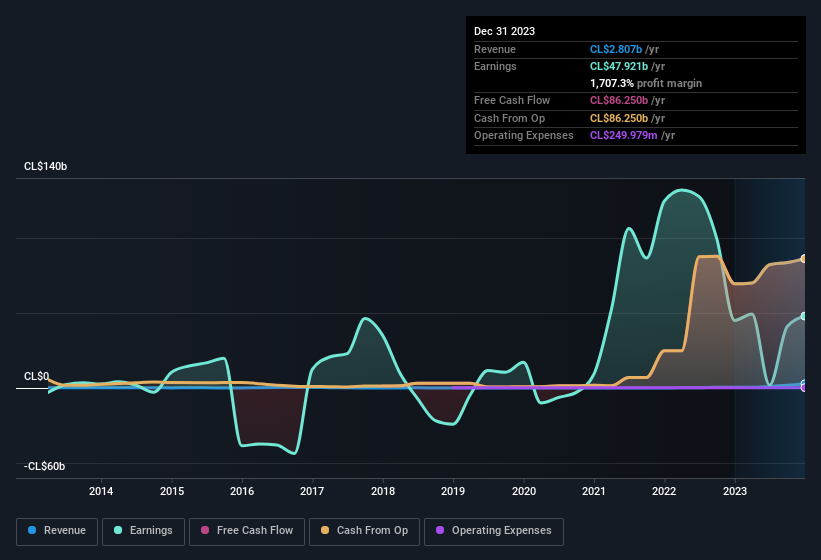- Chile
- /
- Industrials
- /
- SNSE:NAVARINO
We Like Navarino's (SNSE:NAVARINO) Earnings For More Than Just Statutory Profit

The market seemed underwhelmed by last week's earnings announcement from Navarino S.A. (SNSE:NAVARINO) despite the healthy numbers. We did some digging, and we think that investors are missing some encouraging factors in the underlying numbers.
Check out our latest analysis for Navarino

Zooming In On Navarino's Earnings
One key financial ratio used to measure how well a company converts its profit to free cash flow (FCF) is the accrual ratio. In plain english, this ratio subtracts FCF from net profit, and divides that number by the company's average operating assets over that period. You could think of the accrual ratio from cashflow as the 'non-FCF profit ratio'.
Therefore, it's actually considered a good thing when a company has a negative accrual ratio, but a bad thing if its accrual ratio is positive. While it's not a problem to have a positive accrual ratio, indicating a certain level of non-cash profits, a high accrual ratio is arguably a bad thing, because it indicates paper profits are not matched by cash flow. Notably, there is some academic evidence that suggests that a high accrual ratio is a bad sign for near-term profits, generally speaking.
For the year to December 2023, Navarino had an accrual ratio of -0.59. Therefore, its statutory earnings were very significantly less than its free cashflow. To wit, it produced free cash flow of CL$86b during the period, dwarfing its reported profit of CL$47.9b. Navarino's free cash flow improved over the last year, which is generally good to see. Having said that, there is more to the story. The accrual ratio is reflecting the impact of unusual items on statutory profit, at least in part.
Note: we always recommend investors check balance sheet strength. Click here to be taken to our balance sheet analysis of Navarino.
The Impact Of Unusual Items On Profit
Navarino's profit was reduced by unusual items worth CL$40b in the last twelve months, and this helped it produce high cash conversion, as reflected by its unusual items. This is what you'd expect to see where a company has a non-cash charge reducing paper profits. It's never great to see unusual items costing the company profits, but on the upside, things might improve sooner rather than later. We looked at thousands of listed companies and found that unusual items are very often one-off in nature. And, after all, that's exactly what the accounting terminology implies. Navarino took a rather significant hit from unusual items in the year to December 2023. All else being equal, this would likely have the effect of making the statutory profit look worse than its underlying earnings power.
Our Take On Navarino's Profit Performance
In conclusion, both Navarino's accrual ratio and its unusual items suggest that its statutory earnings are probably reasonably conservative. After considering all this, we reckon Navarino's statutory profit probably understates its earnings potential! With this in mind, we wouldn't consider investing in a stock unless we had a thorough understanding of the risks. At Simply Wall St, we found 4 warning signs for Navarino and we think they deserve your attention.
After our examination into the nature of Navarino's profit, we've come away optimistic for the company. But there is always more to discover if you are capable of focussing your mind on minutiae. Some people consider a high return on equity to be a good sign of a quality business. While it might take a little research on your behalf, you may find this free collection of companies boasting high return on equity, or this list of stocks that insiders are buying to be useful.
Valuation is complex, but we're here to simplify it.
Discover if Navarino might be undervalued or overvalued with our detailed analysis, featuring fair value estimates, potential risks, dividends, insider trades, and its financial condition.
Access Free AnalysisHave feedback on this article? Concerned about the content? Get in touch with us directly. Alternatively, email editorial-team (at) simplywallst.com.
This article by Simply Wall St is general in nature. We provide commentary based on historical data and analyst forecasts only using an unbiased methodology and our articles are not intended to be financial advice. It does not constitute a recommendation to buy or sell any stock, and does not take account of your objectives, or your financial situation. We aim to bring you long-term focused analysis driven by fundamental data. Note that our analysis may not factor in the latest price-sensitive company announcements or qualitative material. Simply Wall St has no position in any stocks mentioned.
About SNSE:NAVARINO
Navarino
Through its subsidiaries, manufactures and sells steel parts for mining and grinding balls in Chile and internationally.
Flawless balance sheet with solid track record and pays a dividend.

